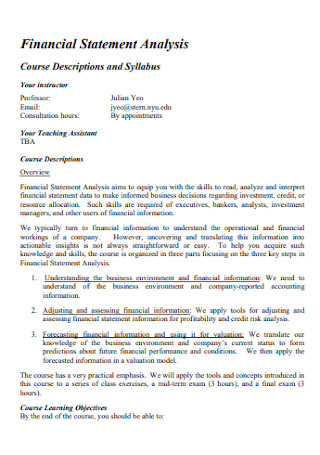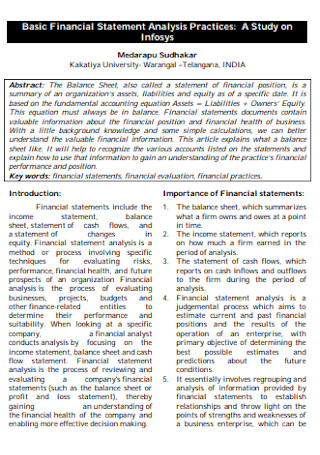39+ Sample Financial Statement Analysis
-

Nature of Financial Statement Analysis
download now -

Financial Statement Analysis Example
download now -

Basic Financial Statement Analysis
download now -

Advanced Financial Statement Analysis Template
download now -

Financial Problem Statement Analysis
download now -

Financial Statement Analysis Report
download now -

Financial Analysis Balance Sheet
download now -

Financial Statement Analysis of Leverage
download now -

Financial Statement and Discussion Analysis
download now -

Emerging Importance of Financial Statement Analysis
download now -

Teaching Financial Plan Analysis Template
download now -

Simple Finacial Statement Analysis Template
download now -

Financial Statement Analysis Format
download now -

Accounting and Financial Statement Analysis
download now -

Financial Course Statement Analysis
download now -

Bank Financial Statement Analysis
download now -

Study Financial Statement Analysis Template
download now -

Financial Statement Analysis in Mergers
download now -

Financial Statement Research Analysis
download now -

Financial Statement Analysis for Non-Profits
download now -

Financial Statement Ratio Analysis
download now -

Printable Financial Statement Analysis
download now -

Financial Accounting Statement Analysis
download now -

Financial Statement Ratio Analysis Template
download now -

Industry Financial Statement Analysis
download now -

Financial Statement Analysis for Decision Making
download now -

Bank Financial Statement Analysis Template
download now -

Business Financial Statement Analysis
download now -

International Financial Statement Analysis
download now -

Case Study of Financial Statement Analysis
download now -

Business Valuation Financial Statement Analysis
download now -

Financial Management Statement Analysis
download now -

School Financial Statement Analysis
download now -

Financial Statement Analysis for Enterprise
download now -

Financial Course Statement Analysis Template
download now -

Banking Institute Financial Statement Analysis
download now -

College Financial Statement Analysis
download now -

Basic Study Financial Statement Analysis Template
download now -

Simple Financial Statement Analysis Example
download now -

Financial Statements and Ratios Analysis
download now
FREE Financial Statement Analysis s to Download
39+ Sample Financial Statement Analysis
What is a Financial Statement Analysis?
Types of Financial Statements
Types of Financial Analysis
How to Develop a Financial Statement Analysis
FAQs
What are some examples of financial statement analysis?
What are the types of financial statements?
What are the types of financial analysis?
Why financial analysis is important for businesses and organizations?
What is a Financial Statement Analysis?
A financial statement analysis is a process of developing an all-inclusive analysis of a business firm or an organization’s financial statements to help business executives, managers, investors, and internal and external stakeholders to understand the overall condition of an organization and to evaluate the business value and financial performance. As a crucial accounting tool, it is used by internal constituents to closely manage and monitor the finances of the business or organization. Small business firms, mid-sized companies, and large corporate firms are required to create and maintain basic financial statements such as the balance sheet, the cash flow statement, and the income statement to create the foundation for financial statement analysis.
A 2022 statistical report revealed the percentage of companies reporting the major benefits of financial analysis such as improved forecasting and budgeting (75%), increased efficiency and productivity (62%), improved decision-making and risk management (58%), better visibility into financial performance (51%), improved regulatory compliance and governance (42%), and increased business revenue and profitability (36%). Thus, gaining clear insights from financial statement analysis helps businesses concentrate on specific metrics, creates more accurate budgets and forecasts, identifies and manages risks, recognizes investment opportunities, evaluates their potential returns, and allows business firms to present complex data using data visualization tools.
Types of Financial Statements
The U.S. Securities and Exchange Commission (SEC) described financial statements as documents that “show you where a company or an organization’s money came from, where it went, and where it is now.” There are many financial statements used by many businesses and institutions that vary from each other.
Types of Financial Analysis
Business firms and corporate firms have different types of financial analysis. Here are some of the most common types of financial analysis:
How to Develop a Financial Statement Analysis
Are you having a hard time developing an accurate, logical, and well-detailed financial statement analysis. Consider following the basic steps in this section to help you easily create a comprehensive and effective financial statement analysis.
Step 1: Define the Industry is Economic Attributes and Business Strategies
Create a value chain analysis for the industry or the chain of activities involved in the creation, manufacturing, and distribution of the company’s products and services. Analyze the economic attributes by using Porter’s Five Forces. Then, determine the nature of the products and services that the company is offering. Take a look at the originality and uniqueness of the product, level of profit margins, creation of brand loyalty, and cost control. Consider other factors such as geographic diversification, industry diversification, and supply chain integration.
Step 2: Assess the Financial Statements of the Business Firm
Examine the main financial statements such as the balance sheet, income sheet, and cash flow statement based on the relevant accounting standards. When you analyze the balance sheet financial accounts, evaluate issues like classification, recognition, and valuation. Check if the balance sheet is the overall representation of the business firm’s economic position. Assess the income statement as you evaluate the quality of earnings and view it as an overall representation of the business firm’s economic performance. Review the cash flow statement to understand the impact of the liquidity position of the business firm on its financial activities over the period.
Step 3: Examine Current Profitability and Risk
Use major financial statement ratios connected to asset management, liquidity, debt management, profitability, and risk or market valuation. Reflect on how profitable the business operations are linked to its assets and how it is profitable from the viewpoint of the equity shareholders. Make a comparative analysis of the current ratios on any financial statement ratios in connection to those from earlier accounting periods.
Step 4: Finalize the Financial Statement Analysis
Make logical and realistic assumptions about the future of the business firm and its industry. Prepare forecasted financial statements and demonstrate how your assumptions will affect the cash flows and funding. Lastly, review and finalize your financial statement analysis.
FAQs
Some examples of financial statement analysis are financial problem statement analysis, college financial statement analysis, banking institute financial statement analysis, enterprise financial statement analysis, school financial statement analysis, financial management statement analysis, business valuation financial statement analysis, international financial statement analysis, industry financial statement analysis, financial statement analysis for non-profits, and financial statement research analysis.
The types of financial statements are cash flow statements, income statements, balance sheets, statements of retained earnings, personal financial statements, and non-profit financial statements.
The common methods used in financial statement analysis are horizontal analysis, ratio analysis, trend analysis, vertical analysis, liquidity analysis, solvency analysis, profitability analysis, scenario & sensitivity analysis, variance analysis, and valuation analysis.
Financial analysis is important because this comprehensive analysis helps the business or organization clearly understand its overall financial health. This tool is beneficial if you need to learn essential techniques to generate wealth, creditworthiness, and profitability. Also, financial statement analysis is integral when it comes to sharing investments and holding, making decisions, developing plans, organizing the management, offering capital credit, and deciding on investments.
What are some examples of financial statement analysis?
What are the types of financial statements?
What are the types of financial analysis?
Why financial analysis is important for businesses and organizations?
A 2023 financial analytics statistical report stated that 72% of business firms and organizations that use financial analysis had increased profitability and 70% of them had improved decision-making. Conducting a financial statement analysis is fundamental to delving through businesses, budgets, projects, and other finance-related transactions to measure their financial health and performance level. Easily access and download from our diverse collection of sample financial statement analysis templates like a financial feasibility analysis and many other analysis templates including a network vulnerability analysis.
